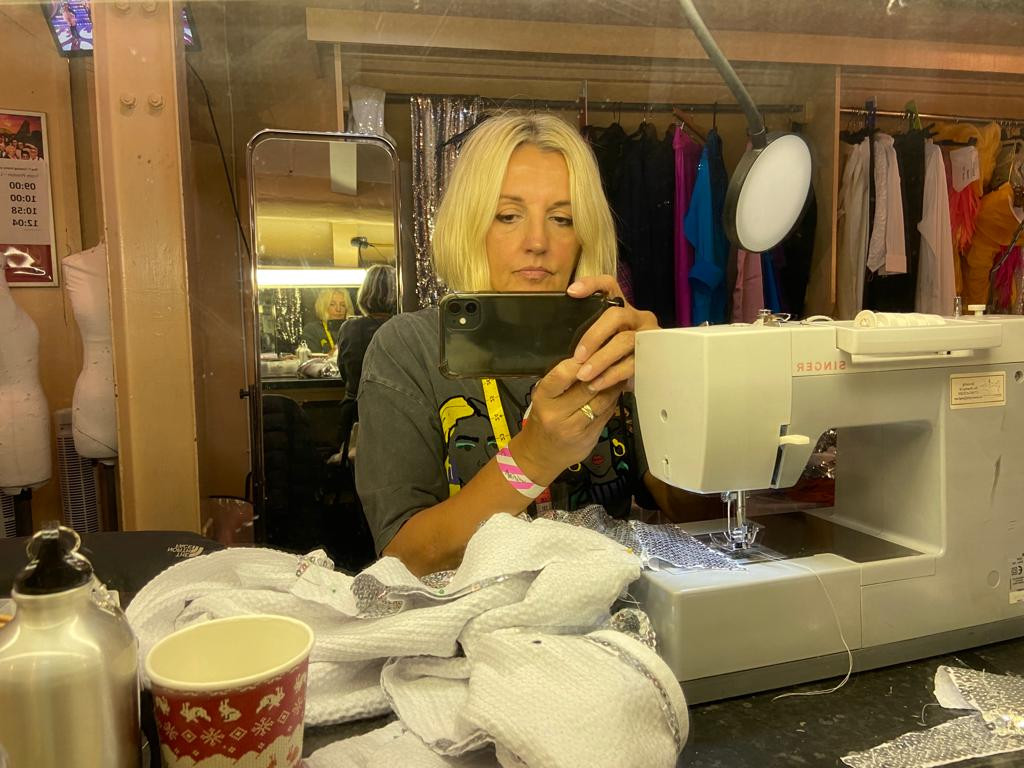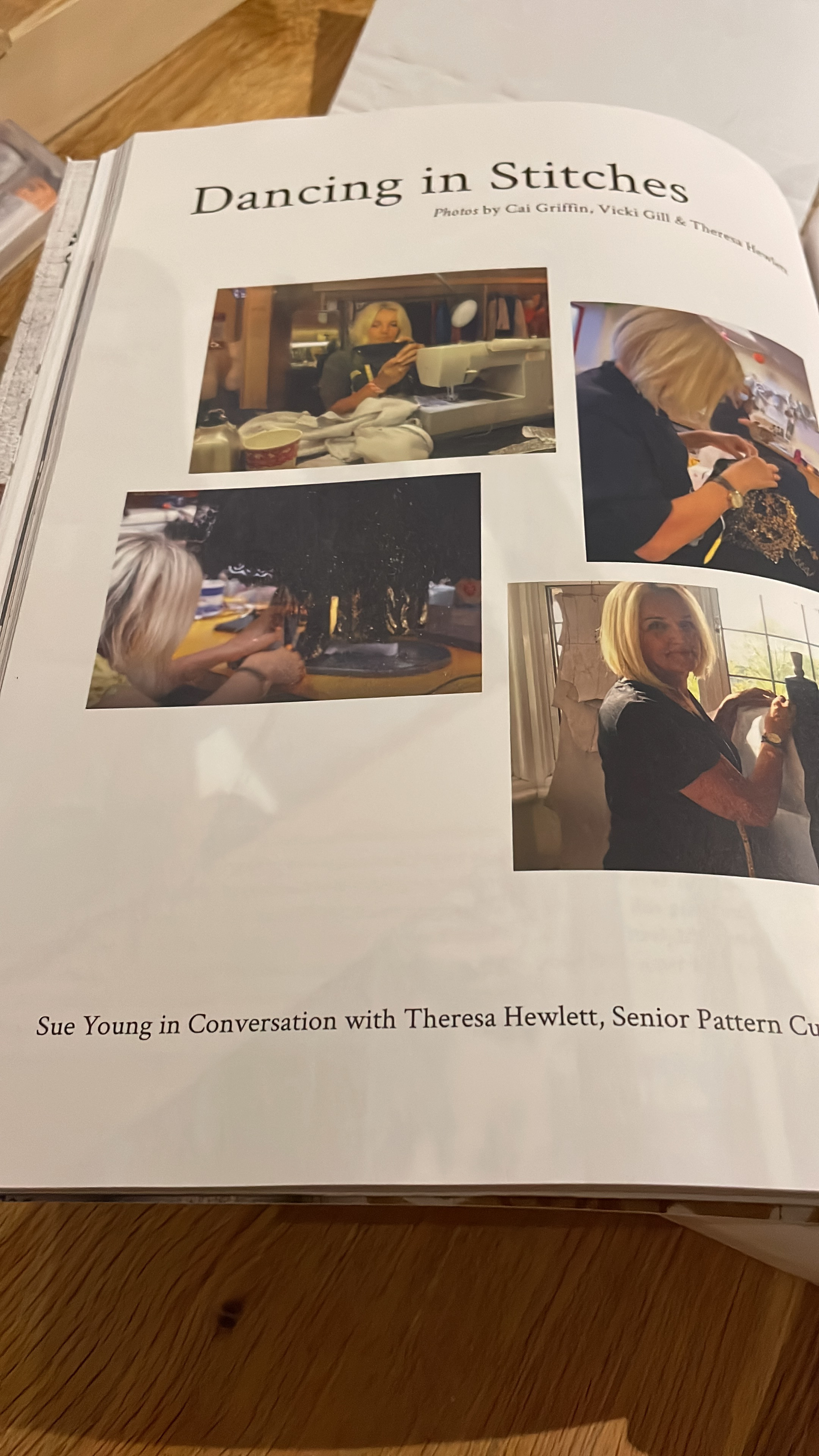In autumn 2023, I had the pleasure of interviewing Theresa Hewlett for a dance-focused edition of Tauko magazine. My connection with Theresa goes back six years to a memorable Strictly Come Dancing themed cruise, which I previously blogged about. Theresa holds the crucial role of senior pattern cutter at DSI London, renowned dance wear specialists. She is the linchpin in transforming design concepts into tangible garments, meticulously catering to the demanding needs of both professional and amateur dancers who grace the dance floor in these creations.
Over a relaxed chat in a Bermondsey pub, accompanied by a glass or two of wine, I delved into the intricacies of Theresa’s profession. I was keen to understand what it truly entails to craft such specialized and unique attire. Given the original article’s word limit for publication, and Theresa’s wealth of fascinating anecdotes, I felt compelled to share more of our conversation here on the blog, with her kind permission.
 Theresa Hewlett and Susan Young at a pub in Bermondsey discussing Strictly Come Dancing costumes
Theresa Hewlett and Susan Young at a pub in Bermondsey discussing Strictly Come Dancing costumes
 Tauko Magazine Issue 10 featuring dance articles
Tauko Magazine Issue 10 featuring dance articles
 Close up of Tauko Magazine Issue 10 cover
Close up of Tauko Magazine Issue 10 cover
SY: Theresa, was working in fashion and clothing always your career aspiration?
TH: Surprisingly, no. Despite my childhood passion for sewing, my initial ambition was to become an archaeologist. I was captivated by ancient civilizations, particularly the Egyptians and figures like Tutankhamun. As I grew older, textile conservation also piqued my interest. However, life took a different turn, and I spent about five years in a rather mundane office job. Eventually, I decided to pursue my creative side and secured a place at the prestigious London College of Fashion to study pattern cutting. This pivotal moment opened doors to diverse roles, including positions with high street brands like Wallis and BHS, where I gained invaluable experience. Subsequently, I had the privilege of working with renowned designers Zandra Rhodes and David and Elizabeth Emanuel at different stages in my career. Even now, I continue to undertake occasional pattern cutting projects for them.
SY: How did you transition into becoming a specialist in dance costumes, particularly for shows like Strictly Come Dancing?
TH: It was truly serendipitous. One day, while on a bus, I happened to notice a clothing factory as we passed by. Later that same day, I spotted an advertisement in the evening newspaper for a pattern cutter at that very factory! It felt like destiny. At the time, they were the leading manufacturers of dance clothing in the UK, catering to the burgeoning world of ballroom and Latin dance. This role immersed me in the specialized world of dance wear, a far cry from high street fashion, and eventually led to my involvement with shows like Strictly Come Dancing.
SY: That must have been a significantly different challenge compared to your previous roles?
TH: Absolutely. While the company was successful, their approach to pattern making and fabric efficiency was quite rudimentary. This resulted in considerable fabric wastage. They predominantly used basic tube shapes in stretchy fabrics, more akin to swimwear construction, with limited consideration for body fit and the specific demands of dance movement. My background in more structured fashion pattern cutting allowed me to introduce more sophisticated techniques, improving both the fit and the economic use of materials in dance costume production. This experience was invaluable when I started working on Strictly Come Dancing costumes, where precision and movement are paramount.
SY: What are the key distinctions between dance wear and ‘regular’ clothing?
TH: Dance dresses are fundamentally constructed around a leotard base. This is crucial for ensuring everything stays securely in place while the dancer is in motion, preventing any wardrobe malfunctions or unwanted exposure during dynamic routines. In high-level competitions, proportions play a critical role. For instance, the skirt of a dress for elegant dances like the Viennese Waltz might be designed to be exceptionally wide and flowing to enhance the visual grace of the movement. Similarly, a female dancer might request the waistline of her costume to be positioned to create a more harmonious aesthetic in relation to her partner’s waistline. In essence, the visual impact is almost as vital as the dance steps themselves. For shows like Strictly Come Dancing, these visual elements are amplified to capture the audience’s attention and enhance the performance on television.
SY: What types of fabrics are typically used in Strictly Come Dancing costumes and dance wear in general?
TH: We utilize a vast array of elastane-based stretch fabrics in a kaleidoscope of colors. For truly unique materials, Vicki Gill, the designer, might venture to Goldhawk Road in London, a treasure trove of specialized fabrics, particularly for sourcing exquisite laces. Remarkably, unless adorned with feathers, most dance dresses, even those heavily embellished with rhinestones, can be machine washed without issue. However, the post-Brexit changes in customs regulations have significantly complicated and increased the cost of sourcing fabrics from outside the UK, presenting new challenges for costume production. This has impacted the availability and pricing of certain specialized fabrics used in Strictly Come Dancing and other dance wear.
SY: Are there discernible fashion trends within dance wear?
TH: Undeniably, fashion trends are just as prevalent in dance wear as they are in mainstream high street fashion. Styles evolve, silhouettes change, and embellishment preferences shift with each season and year. Keeping abreast of these trends is essential in the competitive world of dance and for a show as visually driven as Strictly Come Dancing.
SY: What aspects of your work do you find most rewarding?
TH: I thrive on the variety and the challenge inherent in creating dance costumes! Achieving a perfect fit is paramount. I frequently employ draping techniques directly on the dress stand to realize unconventional shapes and designs. Fittings are particularly enjoyable as they mark the beginning of the transformation of fabric into something truly spectacular. The electrifying atmosphere of working on the live TV show each week is also a major draw. My Fridays and Saturdays are intensely busy, filled with alterations, adjustments, hemming, and last-minute panics – I genuinely thrive in that high-pressure environment. Viewers are completely unaware of the flurry of activity happening behind the scenes. Sometimes, dancers will step onto the stage for the opening of the live Saturday night show and then immediately rush backstage for another quick costume adjustment or fix! Dancers are essentially sewn into their costumes once everything is finalized to guarantee nothing comes loose or shifts during their performance on the dance floor. If we need to stitch additional elements onto a dress while it’s being worn, we sometimes have to carefully insert a ruler inside the garment to create a protective barrier, preventing any accidental needle pricks to the dancer! This level of detail and immediacy is unique to live shows like Strictly Come Dancing.
SY: What type of sewing machine do you rely on – is it a highly specialized, industrial model?
TH: Not at all, surprisingly! I use a Singer Heavy Duty domestic machine, which is incredibly versatile and robust. Its portability is invaluable, allowing me to take it to any location. It handles almost every type of fabric and task I encounter, proving to be a reliable workhorse for creating and maintaining Strictly Come Dancing costumes.
SY: Can you share any memorable dance costume mishaps or near-disasters?
TH: Last year, during rehearsals backstage for the live show, one of the celebrities accidentally gashed her shin with the heel of her dance shoe – there was blood everywhere! She had to be carefully cut out of her tights to receive first aid, and the show’s running order had to be slightly rearranged to accommodate the situation. Eventually, she was patched up, put into two fresh pairs of tights to conceal the bandages, and went on to deliver her best performance of the season! It was a real nail-biting moment, highlighting the unpredictable nature of live television and the resilience required in the world of Strictly Come Dancing.
SY: Are there significant differences in approach between creating costumes for the general ballroom dance world and for a high-profile show like Strictly Come Dancing?
TH: Due to the tighter budgetary constraints on Strictly Come Dancing, we frequently utilize high street clothing as a base and then ‘Strictlyfy’ it. There’s a dedicated team responsible for sourcing suitable garments online, with ASOS being a favorite hunting ground. These found items then undergo a dramatic transformation through embellishment, the addition of rhinestones, extra layers of overskirts or petticoats, strategically placed splits, and often extensive deconstruction and alteration. Sleeves invariably require modification to flatten the sleeve-head, enabling dancers to achieve a smooth and elegant ‘top line’ when raising their arms. Jacket or shirt collars, particularly for the male dancers, often need to be adjusted to sit lower than a standard collar and to prevent them from riding up in a visually distracting manner during movement. If a male dancer’s shirt needs to remain tucked in, the hem is sewn to a pair of Lycra shorts, effectively anchoring the shirt in place. This resourceful approach allows us to create stunning Strictly Come Dancing costumes within budget.
SY: What is the typical cost of a professional ballroom dress outside of the Strictly context?
TH: A professional ballroom dress can range up to around £3000, but they often retain a significant resale value. At DSI, we frequently repurpose elements from older garments to create new designs, particularly components with intricate stoning, as this is both a costly and time-consuming process. This recycling and creative reuse are essential practices in both professional ballroom and in managing the costume demands of Strictly Come Dancing.
SY: Do you have a personal favorite Strictly Come Dancing costume from your career?
TH: Yes, it was a remarkably simple yet elegant white chiffon 1930s-style dress worn by Sophie Ellis Bextor in 2013 for her Viennese Waltz, danced to “My Favorite Things” from The Sound of Music. It was devoid of excessive stoning or frills, just a beautifully draped and flowing gown that perfectly captured the grace of the dance and Sophie’s performance. Sometimes, the most impactful Strictly Come Dancing costumes are those that are understated and allow the dance to truly shine.
SY: Beyond Strictly Come Dancing, what other projects have you been involved in?
TH: I also work part-time as a tutor at London Metropolitan University, which I find incredibly rewarding as I’m working with the next generation of fashion designers. In the past year or so, I’ve had the exciting opportunity to contribute to costume creation for both the Barbie movie and Napoleon, starring Joaquin Phoenix, among other projects. For a ballroom scene in Napoleon, many of the gowns were ingeniously fashioned from repurposed saris. I’ve also designed stage costumes for British bands Bananarama and Girls Aloud for their live shows during the summer of 2024, and for the Coronation concert at Windsor Castle in the summer of 2023. There’s always a diverse range of projects keeping me incredibly busy, and I genuinely love the dynamic nature of my job! The variety extends from the glamorous world of Strictly Come Dancing to historical film and contemporary music performance.
SY: Finally, if you could create a dance costume for absolutely anyone, who would you choose?
TH: (Without hesitation) Dolly Parton! It would be such a fun and exciting challenge to create a costume that perfectly complements her phenomenal figure and larger-than-life personality. Imagine the sparkle and glamour we could create for Dolly on the Strictly Come Dancing stage!
Thank you so much, Theresa, for offering such a fascinating glimpse into your incredibly busy and diverse working life. It’s clear that no two days are ever the same, and it’s a wonder you ever find time to sleep!
Until next time, happy sewing!
Sue
